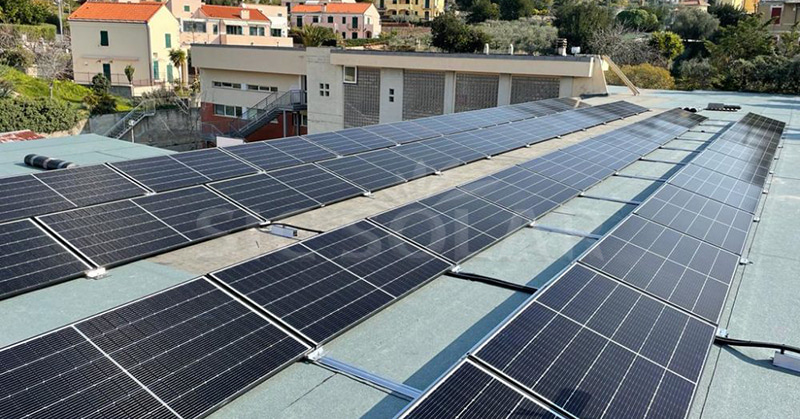As solar energy continues to rise in popularity, many building owners with flat roofs are exploring the feasibility of installing solar panels. While sloped roofs are often associated with residential solar installations, flat roofs provide an excellent opportunity for commercial and industrial solar projects. The short answer is: Yes, solar panels can work on flat roofs, and with the right system in place, they can be highly efficient.
How Solar Panels Can Be Installed on a Flat Roof
Flat roofs offer unique advantages for solar installations, but they also require specific racking solutions to ensure that the panels are positioned at the optimal angle for energy production. In most cases, solar panels on flat roofs are mounted using tilted racking systems. These racks position the panels at the best angle to capture sunlight while preventing shading from nearby panels or roof obstructions.
Benefits of Installing Solar Panels on Flat Roofs
- Maximized Solar Potential One of the key advantages of a flat roof is the flexibility in orienting solar panels. Unlike sloped roofs, which limit the direction panels can face, flat roofs allow for optimal placement and tilt, ensuring that the panels receive maximum sunlight throughout the day. This adaptability means that buildings with flat roofs can take full advantage of solar energy, even in dense urban environments.
- Ease of Installation and Maintenance Flat roofs offer easier access for installing solar panels and conducting maintenance. Solar racking systems can be installed without complex scaffolding, and the horizontal surface makes it safer for installers and maintenance workers to access the system when necessary. This helps reduce installation time and overall labor costs.
- More Available Space Flat roofs generally provide more usable space for solar panels compared to sloped roofs. This allows for larger solar arrays, especially on commercial and industrial buildings. By covering a greater surface area, flat roofs can accommodate more panels, leading to higher energy production and bigger savings on electricity bills.
- Compatibility with Ballasted Mounting Systems One popular racking solution for flat roofs is the ballasted mounting system. These systems use weights, such as concrete blocks, to hold the panels in place, eliminating the need for roof penetrations. This method is ideal for flat roofs because it preserves the roof’s integrity while securing the panels. SIC Solar, a company known for manufacturing photovoltaic mounting systems, offers ballasted systems specifically designed for flat roof installations, ensuring stability without damaging the roof surface.
Types of Racking Systems for Flat Roof Solar Installations
There are two primary racking options for flat roofs: ballasted systems and penetrating systems. Each has its advantages depending on the specific needs of the project.
- Ballasted Racking Systems As mentioned, ballasted racking systems use weight to anchor the solar panels, which makes them ideal for flat roofs where roof penetrations are undesirable. These systems are quick to install and are especially useful in locations with sensitive roof membranes or structures that cannot support penetrative mounting methods. SIC Solar offers highly durable ballasted systems that are designed to withstand wind and other environmental factors while ensuring long-lasting stability.
- Penetrative Racking Systems In cases where additional structural support is needed, penetrative racking systems may be used. These systems are bolted directly to the roof structure, providing extra security in areas with high wind speeds or heavy snowfall. However, they require proper sealing to prevent leaks, making them less popular for flat roofs than ballasted systems.
How to Maximize Solar Efficiency on a Flat Roof
While flat roofs may seem less ideal for solar panels due to the lack of natural tilt, this can be addressed through the use of tilted racking systems. These racks can be designed to tilt the panels at an angle between 5° and 15°, which is typically the optimal range for flat roof installations. This tilt ensures that the panels receive the maximum amount of sunlight throughout the day while preventing the buildup of debris or water.
Additionally, the placement of solar panels should consider potential shading from nearby structures, HVAC units, or other roof equipment. By strategically placing the panels and selecting the right racking system, building owners can ensure their flat roof solar array operates at peak efficiency.
The Role of SIC Solar in Flat Roof Installations
For businesses looking to install solar panels on flat roofs, choosing the right racking system is crucial to the project’s success. SIC Solar, with its extensive experience in producing high-quality photovoltaic mounting systems, provides tailored solutions for flat roof installations. Their ballasted racking systems are ideal for projects where roof penetrations must be avoided, offering a reliable and non-invasive method for securing solar panels.
SIC Solar systems are designed with durability and ease of installation in mind, ensuring that the panels remain securely in place, even in challenging weather conditions. By working with a trusted provider like SIC Solar, building owners can have confidence that their solar installation will deliver maximum energy production and long-term performance.
